O Canada!
It's that time again, Canada! Break out the red and white
striped t-shirt and the fake maple leaf tattoos you've been saving
for the occasion because we're turning 145 years old on July 1st,
2012!
What better way to show off your patriotism this year than by
visiting historic places that helped shape Canada's identity? To
commemorate Canada's special day and evoke national pride, here is
a short history of Canada up to Confederation told through the eyes
of some historic places:
Although there is evidence of Europeans arriving in Canada as
early as the 11th century, Europeans did not truly
settle in Canada until the 16th century. Upon arrival,
contact with the First Nations was immediate and relations between
the two peoples were founded. Hochelaga National Historic Site of
Canada was the location of such an encounter during Jacques
Cartier's second visit to the New World in 1535. Hochelaga, an
Iroquois village, was estimated to have 1500 inhabitants and
contain 50 longhouses at the time of contact, as recorded by
Cartier in his logbook. However, the village was deserted by the
1600s as a new trading alliance between the French, Montagnais,
Algonquin and Huron excluded the Iroquois, forcing the Iroquois to
move from the St. Lawrence Valley and relocate closer to new
trading partners. Today, it is unknown where the actual site is,
but a cairn commemorating this place was erected near McGill
University in Montréal, Québec as a supposed location.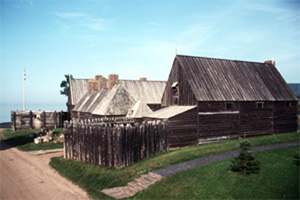
After the "discovery" of the New World, many attempts were made
at settling the land, though it proved to be difficult because of
the harsh Canadian winters. Sieur de Mons was determined to
establish a permanent colony at Port Royal, Nova Scotia in 1605.
Since the original site was destroyed a few years later, the
Port Royal Habitation was re-constructed
in 1939 based on sketches made by Champlain. It gives visitors an
idea of what it was like to live in Canada during the settlement
years of the 15th and 16th centuries. This
important settlement ensured the integration of French culture into
North America.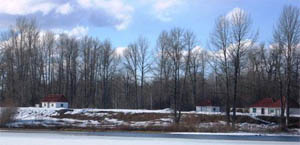
When it was discovered that gold and spices were scarce in
Canada, the fur trade quickly expanded as a lucrative natural
resource. Soon the fur trade companies were racing to establish
posts across Canada. McLeod's Lake Post established in 1805,
is the oldest continuously-occupied fur trade post in British
Columbia involving interaction between Aboriginals and Europeans.
Constructed by the Northwest Company and then controlled by the
Hudson's Bay Company in 1821 after the merger of both companies,
the post was relocated in 1823 near the community of McLeod's
Lake and its trading partner, the Tsek'ene Village, where it
operated for another 148 years. What makes this post truly unique
is that it is one of the only Hudson's Bay Company structures to
never have defensive measures put in place.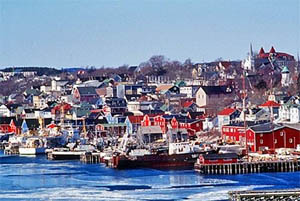
On the East Coast, the fur trade was soon replaced by fishing as
the main source of income. Established in 1753 as a British
colonial town, Lunenburg Old Town Heritage Conservation
District is an exceptional example of a fishing community in
the East. Home to mainly German, French and Swiss colonists,
Lunenburg is a well-preserved heritage district illustrating
18th century colonization and settlement patterns with
outstanding examples of vernacular architecture spanning 240 years.
It is closely associated with the fishing and shipbuilding
industries. 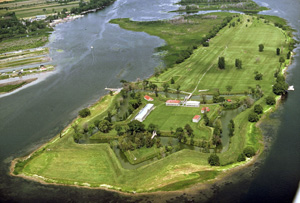
Disputes between the American colonies and Canada were frequent.
One of the most memorable conflicts between the two countries that
occurred was the War of 1812. Built in 1759, Fort Lennox was an important asset for
the British during the War of 1812, as this fortification prevented
invasions by Americans along the strategic Richelieu River and
could repulse an American attack of Lower Canada, thus preventing
the Americans from taking Montréal and Québec (the two most
important cities in colonial Canada at the time).
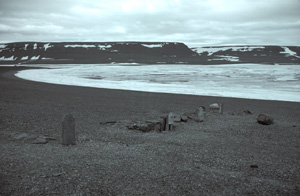 Throughout the formation of Canada, one goal that
remained a priority well into the 19th century was the
discovery of the Northwest Passage in the Canadian Arctic. The
famed Franklin Expedition of 1845 to search for the passage was
tragically lost and later searches for the ship and attempts to
solve the mysterious disappearance still continue today. Beechey Island in Resolute, Nunavut, was
the starting point for many investigations into the disappearance
as it was the last known site visited by Franklin and his men. The
gravesites of three of the crew were discovered on the island and
forensic analysts gained valuable
Throughout the formation of Canada, one goal that
remained a priority well into the 19th century was the
discovery of the Northwest Passage in the Canadian Arctic. The
famed Franklin Expedition of 1845 to search for the passage was
tragically lost and later searches for the ship and attempts to
solve the mysterious disappearance still continue today. Beechey Island in Resolute, Nunavut, was
the starting point for many investigations into the disappearance
as it was the last known site visited by Franklin and his men. The
gravesites of three of the crew were discovered on the island and
forensic analysts gained valuable  information into the ill-fated
expedition. This event was important for Canada as it eventually
resulted in the mapping of the Canadian Arctic Archipelago and
reinforced Canada's motto of sea to sea to sea.
information into the ill-fated
expedition. This event was important for Canada as it eventually
resulted in the mapping of the Canadian Arctic Archipelago and
reinforced Canada's motto of sea to sea to sea.
Leading up to Confederation, the Public Grounds of the Parliament Building
National Historic Site of Canada in Ottawa, Ontario,
constructed in 1859, embody Canada's evolution from colonies to an
independent democratic government. 1867 marked the close of
Canada's colonial chapter and the opening of a new era as an
independent country. What better way to commemorate the birth of
our nation than by taking part in the national celebration this
July 1st on Parliament Hill in Ottawa?
On Canada Day, take the time to visit some historic places in
order to see how our country has developed since the
16th century!